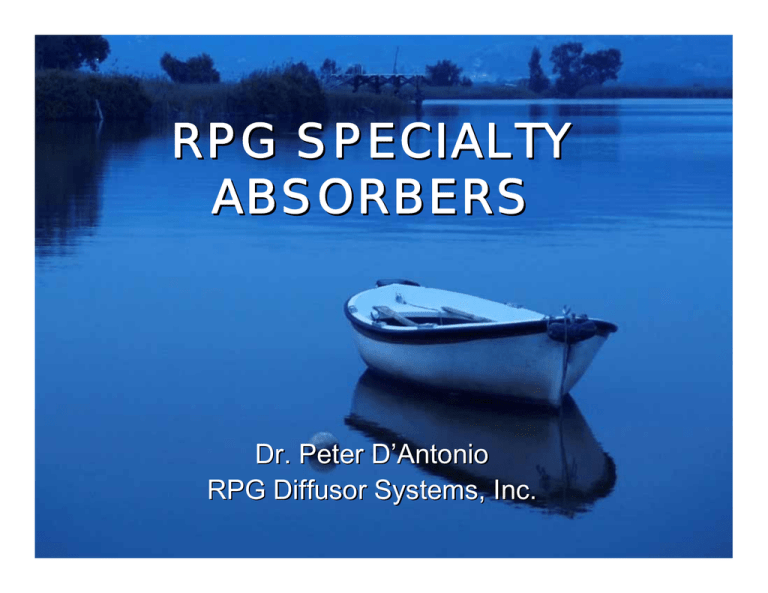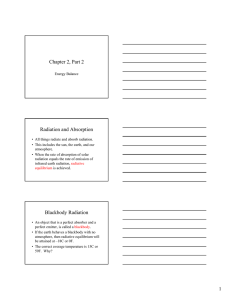RPG Specialty Absorbers
advertisement

RPG SPECIALTY ABSORBERS Dr. Peter D’Antonio Dr. Peter DSystems, ’Antonio RPG Diffusor Inc. RPG Diffusor Systems, Inc. Absorbers: Parametrix NRC 1 Absorption Coefficient 0.8 0.6 0.4 0.2 0 0 50 100 150 200 250 300 Frequency, Hz/10 350 400 450 500 Acoustic Absorbers Helmholtz Resonators ∅=2a D Perforated sheet Porous absorbent t d Rigid backing Surface Impedance z 1 = rm + j [ω m − ρ c cot( kd ) ] The resistance or real term, which is associated with energy loss The acoustic mass or imaginary term is associated with phase change or resonant frequency k = 2p l the wavenumber in air; d the cavity depth; m the acoustic mass per unit area of the panel; wr the angular frequency = 2p f the density of air, and c the speed of sound in air Resonant Frequency At resonance, the imaginary term goes to zero w m = 2p fm = rc cot(kd ) The cavity size is much smaller than the acoustic wavelength, i.e. kd<<1, so that cot(kd)→1/kd c f = 2p r md This is the basic design equation for resonant absorbers, i.e. Helmholtz, Membrane and Plate resonators Helmholtz Acoustic Mass/Unit Area 2 ’ È ˘ 8n Ê t ˆ rD rD t m= t + 2d a + ÁË1 + ˜¯ ˙ = 2 Í 2a ˙˚ p a 2 p a ÍÎ w 2 - The last term in the equation is due to the boundary layer effect, and ν is the kinematic viscosity of air. This last term is often not significant unless the hole size is small, say sub-millimetre in diameter. - δ is the end correction factor (not allowing for mutual interaction), which to a first approximation is usually taken as 0.85 and derived by considering the radiation impedance of a baffled piston. Other more accurate formulations exist. - t’ includes the end correction factor When Your Project Calls for CMU Finish R A D Acoustical CMU Acoustical Properties Slotted/Unsealed Slotted/Sealed Absorption Coefficient Unslotted/Unsealed Unslotted/Sealed Transmission Loss High School Auditorium Gymnasium Music Rehearsal Band Room Gymnasium Noise Control Chiller Hybrid LF Diffsorber • The Helmholtz resonator slots provide low frequency absorption and the reflection phase grating provides mid-high frequency diffusion When Your Project Calls for Visibility/Light Transmission R A D Absorption Mechanism When surface perforations are the same size as a boundary layer of air. Viscous Losses Reflected Sound Incident Sound Microperforated Panel 0.5 mm diameter holes Air Cavity NEW Glass Microperforated Absorbers 2 rD m= 2 pa È 8n Ê t ˆ˘ Ít + 2d a + ÁË1 + ˜¯ ˙ 2a ˙˚ w ÍÎ The last term in the equation is due to the boundary layer effect, and ν is the kinematic viscosity of air. This last term is often not significant unless the hole size is small, say sub-millimetre in diameter. The end correction δ is increased by the boundary layer effect and resonant frequency is reduced due to an increase in acoustic mass . Losses 2wrh z 1 j1.7wra zh = + - j rc cot(kd ) + e 2e e • • • Generally the resistive term in Helmholtz absorbers is very small and to get good absorption it is necessary to add porous material to the cavity. However, when the holes are sub-millimeter the resistive term (in red above) is very large Consequently, no porous material is needed in the cavity Sound Absorption Data 1 Layer of Foil 30 mm off Glass 2 Layers of Foil 50 mm off Glass 30 mm off Glass 50 mm between layers 100 mm off Glass 30 mm off Glass 100 mm between layers Effect of Layers/Backing Foil & Mounting Polycarbonate Foils Botanical Gardens Atria Courtyard Laser Micro-Slotted Panels Scenery Overlook Partitioning Custom Design Translucence Absorptive Glazing Light Transmitting Microslit Microslit Advantages • • • • • • Fiber-Free (i.e. does not require porous fiberglass backing) Light-transmitting Can be fabricated in large panels Slit pattern can be linear, sinusoidal, triangular, custom Thickness ranges from 2 mm to 20 mm Can be directly attached to window mullions with velcro or suspended in front of glazing with standard decorative hardware • Can be fabricated from acrylic, PETG or recycled PETG (slightly cloudy) • Very absorptive in mid and low frequency regions which are typically difficult to treat Absorptin Data Micro Perf vs. Micro Slit Deamp Microslit Baffles Acoustical baffle PETG Variation1. 2743mm long 457mm Height Upper width: ~227mm Lower width: 100mm Slot c-c 10mm, slot lengths 3x 112mm Deamp Microslit Baffle Acoustical baffle PETG Variation2. 2743mm long 457mm Height Upper width: ~187mm Lower width: 60mm Slot c-c 10mm, slot lengths 3x 112mm Limp Membrane Resonator Membrane Porous absorbent ta d Rigid backing c f = 2π ρ md 60 f = md r = 1.21 kg / m3 c = 340 m / s LF Band Cut Absorbers • Membranes- are essentially pressure transducers. They operate where the pressure is high and the particle velocity is low- I.e. near a boundary. They convert pressure fluctuations into air movement in a frequency range determined by the mass and compliance of the membrane and the air cavity depth. Low Frequency Absorption Impedance Tube Measurements 1 Absorption efficiency decreases with frequency, because the impedance of the porous material moves further from the characteristic impedance of air at low frequencies. 2" Cavity 0.9 4" 6" 0.8 6"+Damp 8" 10" Absorption Coefficient 0.7 0.6 0.5 0.4 0.3 0.2 0.1 0 40 60 80 100 120 Frequency, Hz 140 160 180 Plate Resonators High Pass Broadband Plate Resonators Mechanisms Pistonic Resonance Steel Plate Perf Metal Damp Bending Modes Polyester Diffraction High Pass Broadband Above these frequencies absorption occurs from diffraction of the sound around the plate into the porous absorber Plate Parameters F A E= x H Δr R υ= x H F Young’s Modulus Stress/Strain Units N/m2 or psi x H R Δr Poisson’s Ratio Transverse Strain/Vertical Strain steel density melamine density c in m/s E steel, Pa Kg/m3 Poissons ratio Kg/m3 melamine L, m W, m T, m n m 2.06E+11 7850 0.3 9.5 340 1 1.5 0.001 1 1 0.0025 2 2 3 3 4 4 fnm bending fnm bending 1mm, Hz 2.5, Hz f piston 1mm, Hz f piston 2.5mm, Hz 3.52 8.79 188.25 119.06 14.07 35.17 31.66 79.14 56.28 140.69 Modex Plate & Broadband In-wall installation Performance 1.6 Absorption Coefficient 1.4 Broadband 1.2 1 0.8 0.6 Plate 0.4 0.2 0 50 160 500 Frequency, Hz 1600 5000 A/V Conference Room 1,2 Reverberation time [s] 1 0,8 0,6 0,4 0,2 0 32 63 125 250 500 1000 2000 4000 Frequenzcy [Hz] no Absorber with Absorber 8000


